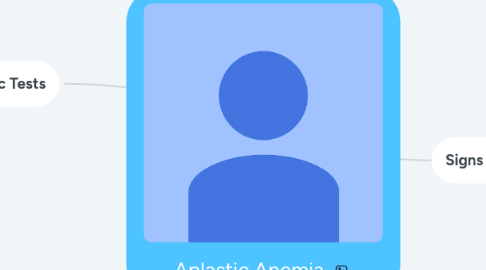
1. Risk Factors
1.1. Exposure to toxins
1.2. Have taken certain medicines or had radiation or chemotherapy (treatments for cancer)
1.3. Have certain infectious diseases, autoimmune disorders, or inherited conditions
2. Diagnostic Tests
2.1. Family History
2.1.1. Questions asked by a Physician
2.1.1.1. You've had anemia or a condition that can cause anemia You have shortness of breath, dizziness, headaches, or other signs and symptoms of anemia You've been exposed to certain toxins or medicines You've had radiation or chemotherapy (treatments for cancer) You've had infections or signs of infections, such as fever You bruise or bleed easily
2.2. Complete Blood Count
2.2.1. Tests that check vitamin B12 and folate levels in the blood. These tests can help rule out anemia caused by vitamin deficiency
2.3. Reticulcyte Blood Count
2.4. Bone Marrow Tests
2.5. Other Tests
2.5.1. Xray, CT, Liver Tests and Viral Scans
3. Common Findings
3.1. History of recurrent infection
3.2. Tachycardia
3.3. Fatigue
3.4. Pallor
3.5. History of easy bruising and bleeding
3.6. Dyspnea
4. Causitive Factors
4.1. Acquired
4.1.1. Toxins, such as pesticides, arsenic, and benzene. Radiation and chemotherapy (treatments for cancer). Medicines, such as chloramphenicol (an antibiotic rarely used in the United States). Infectious diseases, such as hepatitis, Epstein-Barr virus, cytomegalovirus, parvovirus B19, and HIV. Autoimmune disorders, such as lupus and rheumatoid arthritis. Pregnancy. (Aplastic anemia that occurs during pregnancy often goes away after delivery.) Sometimes, cancer from another part of the body can spread to the bone and cause aplastic anemia.
4.2. Inherited
4.2.1. Certain inherited conditions can damage the stem cells and lead to aplastic anemia. Examples include Fanconi anemia, Shwachman-Diamond syndrome, dyskeratosis (DIS-ker-ah-TO-sis) congenita, and Diamond-Blackfan anemia.
5. Signs and Symptoms
5.1. Red Blood Cells
5.1.1. A lack of hemoglobin in the blood causes fatigue. A low red blood cell count also can cause shortness of breath; dizziness, especially when standing up; headaches; coldness in your hands or feet; pale skin; and chest pain. If you don't have enough hemoglobin-carrying red blood cells, your heart has to work harder to move the reduced amount of oxygen in your blood. This can lead to arrhythmias (irregular heartbeats), a heart murmur, an enlarged heart, or even heart failure.
5.2. White Blood Cells
5.2.1. White blood cells help fight infections. Signs and symptoms of a low white blood cell count include fevers, frequent infections that can be severe, and flu-like illnesses that linger.
5.3. Platelets
5.3.1. People who have low platelet counts tend to bruise and bleed easily, and the bleeding may be hard to stop. Common types of bleeding associated with a low platelet count include nosebleeds, bleeding gums, pinpoint red spots on the skin, and blood in the stool. Women also may have heavy menstrual bleeding.

